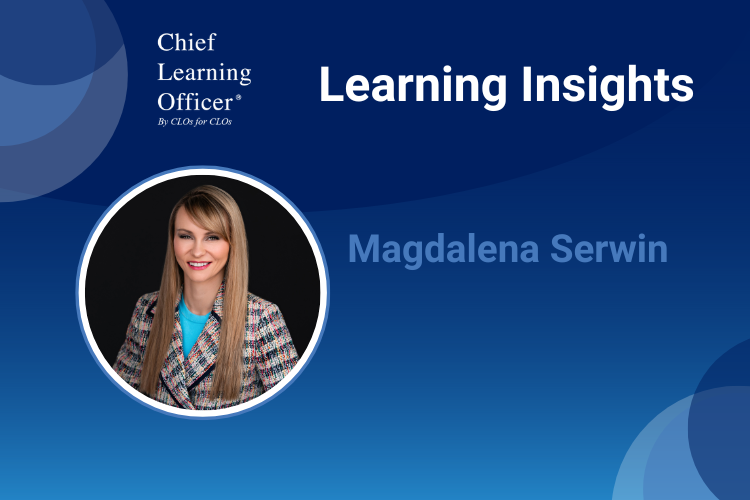Chief Learning Officer’s “Learning Insights” series is dedicated to showcasing the thoughts and career journeys of chief learning officers and learning executives—the tireless trailblazers who are transforming the landscape of corporate learning and workforce development. In this Q&A series, we garner strategic insights, innovative approaches and challenges overcome from visionary leaders worldwide.
CLO: What initially drew you to a career in learning and development, and how have your experiences evolved over the years?
I’m thrilled to share my journey, especially as it has taken a few unexpected turns along the way! Initially, my ambition was to become a police officer as I’ve always been passionate about helping people. However, the taxing nature of the job deterred me. My interest in law persisted though, and l completed a master of laws specializing in information technology.
My professional journey in education began at the National Judicial Institute. I helped build online education capacity for Canadian judges. I even went on to create international online programs with judicial colleges around the world. Let me remind you, this was years before the pandemic when online education was somewhat of a novelty at the time. While my education so far was predominantly in law, I ended up upskilling in adult education and instructional design to create impactful learning experiences.
I transitioned to the health care sector at the Medical Council of Canada. There, I led a team to develop crucial preparatory tools for international medical graduates striving to practice medicine in Canada—a government-supported initiative to address the shortage of physicians here. This role deepened my expertise in assessments.
My curiosity brought me to Smart and Biggar, Canada’s largest intellectual property law firm. Starting from scratch, I built a comprehensive learning and development program. This gave me experience in talent development, compliance and all L&D internally.
Being a resident of Ottawa, a government city, I was eager to experience the public sector, so I joined the Canadian Border Services Agency. There, I worked on computer-based and simulation assessments for candidates who were aspiring to protect Canada’s borders. I was part of the working group that pioneered a particularly exciting virtual reality project that safely evaluated candidates in what could be high-risk scenarios in real life.
I later moved to Chartered Professional Accountants of Canada, leading high-visibility design and development programs like the globally recognized In-Depth Tax Program, and learning initiatives in ESG and sustainability, and the public sector. So far, it’s been an interesting journey working in diverse industries.
CLO: What key initiatives have you implemented as a learning leader to drive employee development and foster a learning culture?
As a learning leader, one of my key initiatives has been the development and facilitation of a comprehensive nine-month leadership development program tailored specifically for managers. Witnessing the growth and development of the participants throughout the program was incredibly rewarding, particularly seeing individuals achieve promotions as a direct result of their participation and commitment to learning.
In my perspective, the most significant advancement in leadership development lies in cultivating a deeper understanding of one’s self-awareness. By fostering a keen awareness of our own strengths, weaknesses, values and motivations, we lay a solid foundation for developing emotional intelligence and enhancing various leadership competencies.
CLO: What is the most impactful learning program you’ve introduced in your organization, and how has it contributed to employee growth and business success?
Well, it’s difficult to choose just one, as I’ve had the privilege of working on several impactful learning programs ranging from an international judicial education program on child pornography law and the internet to police powers of arrest, to the acclaimed three-year In-Depth Tax Program at CPA Canada which included so many learning assets for the in-person and virtual components.
What brings me the most satisfaction is witnessing the growth of our participants once they interact with the program. In addition, providing my team with the tools for them to excel in their roles. I also find great fulfillment in the strategic aspect of my roles.
CLO: What is a common misconception people might have about the L&D function, and how do you address it?
That it is easy to outsource the design and delivery of learning solutions. Outsourcing learning projects has been an effective strategy in my experience, especially when my internal team was engaged with other critical projects. It’s an excellent way to distribute risk and tap into external expertise quickly.
However, I firmly believe in the indispensable value of maintaining an in-house learning team. My team’s deep understanding of our brand and their unwavering commitment to excellence are irreplaceable. They have a keen eye for nuances that external vendors might overlook. Even when you outsource work, depending on the breadth and scope of the product, it still takes a lot of effort from internal teams. Despite its benefits, the cost of outsourcing is rising, which brings us to an important point: Understanding the ROI of learning initiatives, whether they are conducted internally or through outsourcing.
CLO: What excites you the most about the future of workplace learning, and how are you preparing your organization to adapt to the changing landscape?
I’m a continuous learner—it’s genuinely a natural strength of mine, as confirmed by my StrengthsFinder Assessment where “learning” emerged as a top trait.
As mentioned, my academic background was in law and instructional design, yet I’ve consistently sought to broaden my knowledge throughout my career, acquiring in-demand certifications. My approach has always been to identify and fill any gaps in my knowledge and skills to stay ahead in my field.
I give my team the same advice. Continue to upskill yourself. The world and technology are moving at rapid speeds and we need to adapt and continue to learn no matter what field we are in. It’s important to continue to reflect on where you are at, where you want to be, and create and action a plan for how you will get there through learning/training.
CLO: What essential qualities or skills make a successful L&D leader, and how do you cultivate these traits in yourself and among your team?
One of the most challenging aspects of being a learning leader, business leader first, has been the process of stepping into new roles and recognizing the need for immediate changes to propel the team and organization forward. This often means making tough decisions, such as halting initiatives that don’t align with our strategic goals, or even performance managing, upskilling and occasionally having to let staff go. Additionally, integrating new technologies to enhance cost efficiency and improve operational management has been crucial, yet challenging.
Leadership involves many difficult moments—there’s a lot of deep thinking and genuine heart that goes into each decision. Not everyone will agree with these decisions and there are times when the leader isn’t so popular. What’s vital, however, is having the confidence to make the right choices and practicing resilience in the face of adversity. These experiences have taught me the importance of staying true to my vision for the team’s future and the overall mission of the organization. It’s about leading with your values, courage and integrity, ensuring we’re always moving toward greater impact.
In terms of fostering these qualities within my team, we discuss our values. I also believe in leading by example and cultivating an environment where open dialogue and diverse perspectives are encouraged.
CLO: What game-changing advice would you offer if you could go back in time and mentor your younger self?
This year, I’ve had the chance to take part in a few university and college career fairs, where I’ve shared my experiences in L&D. These events aim to shed light on the realities of working in HR and the different paths one can take in this field. It’s awesome to witness the enthusiasm of the next generation of leaders as they explore potential career avenues in L&D. The students are always surprised that L&D can be expanded to continuing education in different areas and professions. For example, you don’t just have to work in organizational development. You can also work on creating learning solutions for external members in different associations.
For those interested in L&D, I encourage attending career fairs. They offer great networking opportunities and insights into the various career paths available. As one establishes themselves in the field, I suggest seeking additional education that complements your expertise.
CLO: What do you feel is currently the single biggest challenge facing L&D professionals and the industry as a whole?
I’m sure everyone would expect me to say artificial intelligence and that would be very true. However, I will delve into another challenge that I’m passionate about: Learning ROI is not integrated well within most organizations and learning decisions aren’t based on data. To me, this is a lack of accountability on decision-makers. I recently wrote an article for Chief Learning Officer that discussed strategies for how you can integrate it within the fabric of your organization. The setback is really about organizations not having a culture that values learning ROI in the first place. The article provides a number of useful strategies for action and crucial conversations to initiate.
CLO: We’re always looking to showcase innovative tools and technologies. Can you share one work or learning tech product or platform that has significantly improved your work processes and why you find it valuable?
I’ve equipped my team with cutting-edge tools such as AxesWord, AxesPDF and MadeToTag. These technologies have cut down the time required to make documents accessible by 50 percent, significantly easing the workload on my team while ensuring that our resources are usable by everyone.
Interested in being featured in our “Learning Insights” series? Please complete this FORM.















